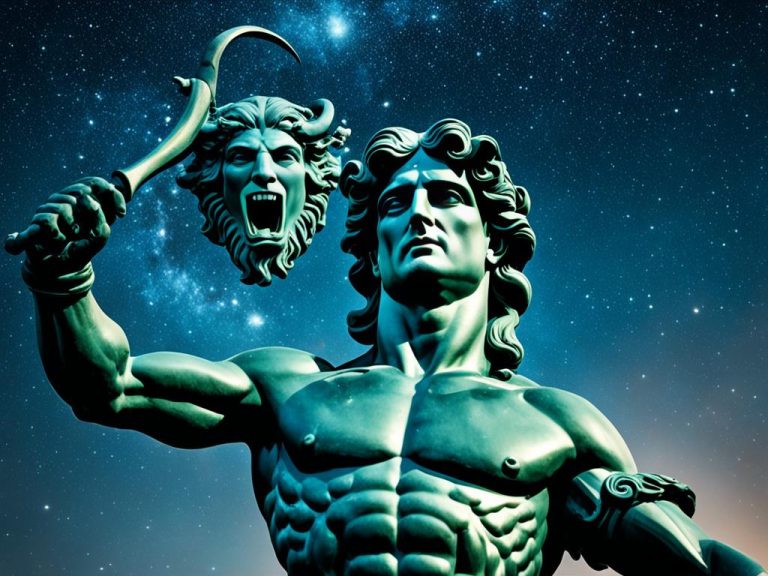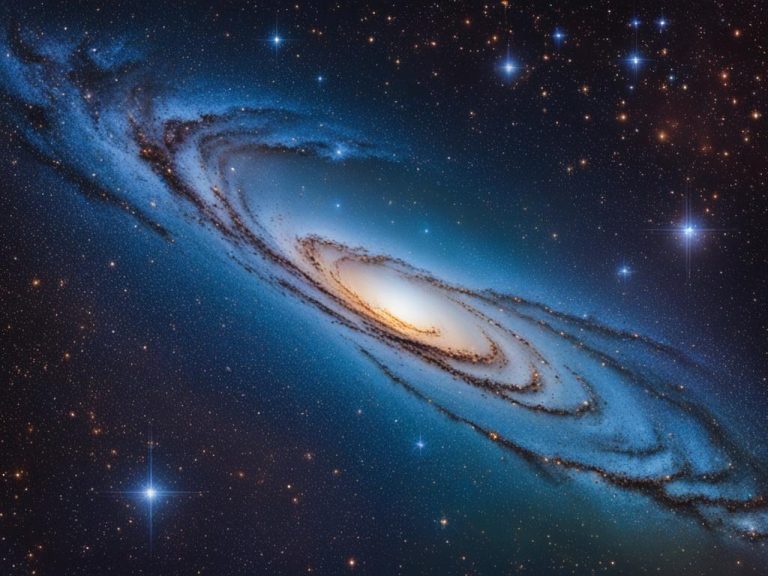Explore the Stars in the Perseus Constellation
Modified: June 28, 2024 Author: International Star Registry
Did you know that the Perseus constellation is among the larger groupings in our night sky? It’s situated in the northern sky and known for its engaging stories from ancient Greece. Additionally, Perseus showcases beautiful sights in the night sky and hosts a yearly meteor shower, making it a place many find magical.

Key Takeaways:
- The Perseus constellation is named after the hero Perseus in Greek mythology.
- It is one of the larger constellations in the northern sky.
- Perseus is renowned for the annual Perseid meteor shower.
- Deep sky objects in Perseus include the Double Cluster, Messier 34, the California Nebula, and the Little Dumbbell Nebula.
- International Star Registry offers a unique and memorable gift of naming a star within the Perseus constellation.
Perseus Constellation Facts
Perseus is in the northern sky, making it the 24th largest constellation. It covers 615 square degrees. You can see it from latitudes +90° to -35°.
Seven constellations surround Perseus. These are Andromeda, Aries, and others. Its history goes back centuries, first noted by Ptolemy in the 2nd century. It’s part of the 88 modern constellations today.
The Perseid Meteor Shower is an exciting annual event. It lights up the sky from July to August. This show comes from within Perseus, delighting stargazers.
Mirfak, or Alpha Persei, is its brightest star. It’s a supergiant about 590 light-years away. Zeta Persei, a blue-white supergiant, and Epsilon Persei are also notable.
The California Nebula is one of the interesting things in Perseus. It’s an emission nebula. Telescopes can capture its beauty in the night sky.
The Perseus constellation offers much interest. Its stars, deep-sky objects, and history fascinate many. To find more, check out this informative website or this educational resource for kids.
How to Find Perseus
If you want to see the beauty of the night sky, try looking for Perseus. This group of stars is easy to spot. It’s known for its unique shape and other well-known patterns around it. Finding Perseus can be a fun and simple task for both new and experienced sky watchers.
Using Star Patterns
Start at Gamma Cassiopeiae and go towards Ruchbah. This is the right star of Cassiopeia’s W shape. Then, head to Mirfak, Perseus’s brightest star. Mirfak is also visible from Andromeda and Pegasus. It looks like it’s part of a line with their stars. This makes it easy to find where Perseus is in the sky.
Celestial Navigation
Already know your way around the stars? Try using the North Star, Polaris, to locate Perseus. The North Star is at the tip of the Little Dipper’s handle. It doesn’t move much in the sky. After finding the North Star, follow the right direction to Perseus. This way, you can reach Perseus easily.
Checking out the Perseus star cluster is an amazing adventure. All you need is a telescope or even just binoculars. Then, look up at the sky to enjoy the beauty of the Perseus constellation.
The Mythology of Perseus
Who was Perseus? Perseus is a key character in Greek mythology. He is famous for his brave deeds and amazing adventures. Perseus was the son of Danaë and predestined for greatness. His main mission was to kill the fearsome Gorgon Medusa. Medusa could turn anyone who looked at her into stone.
Athena, the wise goddess, gave Perseus a shield. It was made of bright bronze and acted as a mirror. With this shield, he could face Medusa without being turned to stone. Then, Hermes, the messenger god, gifted him winged sandals. These sandals allowed Perseus to fly quickly and quietly. Hades, god of the underworld, gave him an invisibility helmet. This helmet helped him surprise his enemies. Lastly, the skilled Hephaestus made him a sharp, diamond sword.
Equipped with these special gifts, Perseus headed to find Medusa. Instead of looking at her directly, he used the shield to see her through her reflection. He then attacked and cut off her head with his sharp sword. He put her head in a magic bag that he carried everywhere.
On his way, Perseus met Andromeda, a princess in great danger. She was tied to a rock to be eaten by a sea monster. He killed the monster and saved her life. They fell in love and married. Perseus became the father of many kings in Persia.

Perseus’ story is well-known in Greek myths. It shows how bravery and cleverness can overcome any obstacle. His legend is still popular today, inspiring people to be determined and creative in tough situations.
International Star Registry: A Perfect Gift for Any Occasion
Imagine immortalizing your loved ones or commemorating a special occasion by naming a star in the Perseus constellation. With International Star Registry, you have the opportunity to bestow a celestial name upon a star within this captivating constellation. Whether it’s a birthday, Christmas, or anniversary, naming a star is a timeless and unique gift that will be cherished for a lifetime.
You get a special certificate when you buy a star for someone. It shows the star’s name and where it is in the sky. You can also add a message to make the gift even more personal. You also receive a star map. It shows exactly where your star is in the night sky. This makes it easy for the person to find their star.
Naming a star is easy. Just go to International Star Registry’s website at www.starregistry.com. Choose a package that fits what you want. It only takes a few minutes to complete your order.
International Star Registry has been around since 1979. They have named stars for many people. Some celebrities that have their very own stars named in Perseus include Tom Cruise, Mariah Carey, Phil Bruns, Adam Sandler, Don Henley, Michael Jackson, Sam Kinison, Mark Hamill and George Walker Bush.
Perseus and Other Constellations in the Sky
Perseus is known for its exciting story and place in the sky. It works with other constellations like Andromeda and Cassiopeia to tell tales from the stars.
Andromeda sits to the west of Perseus in the night. She’s named after a princess saved by Perseus from a scary sea beast. This makes her a key part of Perseus’s story.
To the north of Perseus, you’ll see Cassiopeia shining bright. This group of stars looks like a queen seated on her royal throne. Queen Cassiopeia is Andromeda’s mother.
Perseus, Cassiopeia, and Andromeda form an interesting trio in the sky. Close to each other, they’re easy to spot. They make looking at stars a fun story time.
Perseus, Andromeda, and Cassiopeia aren’t just stars. Their stories and beauty make them a joy to see for everyone. They show how rich and captivating our night sky is.
Notable Stars in Perseus
In Greek myths, Perseus is a hero known widely. Apart from his stories, he gave us some amazing star sights to see. In the Perseus constellation, several stars stand out.
One famous star is Algol, called Beta Persei, the Demon Star. Algol is a special kind of star pair. They make it look like Algol’s light is getting brighter and dimmer. This has amazed people who study stars for a long time.
Mirfak is another bright star, known as Alpha Persei. This supergiant star lights up the night as the biggest in the constellation. It helps make Perseus one of the main things we see in the sky.
Perseus has a lot of stars that change in brightness, called variable stars. AG Persei and Phi Persei are examples. They each have interesting ways they get brighter and darker. These stars help astronomers learn more about how stars grow and change.
When you look at the stars of Perseus, think about the amazing Algol and Mirfak. Also, get amazed by the changing lights of stars like AG Persei and Phi Persei. These stars show us how big and surprising the universe is.

Deep Sky Objects in Perseus
Perseus is the 24th largest constellation, filled with amazing stars and deep sky objects. These objects are favorites of both astronomers and stargazers. Let’s look at some of the most interesting ones in Perseus.
Messier 34 (M34)
Messier 34, known as M34 or NGC 1039, is a special open star cluster in Perseus. Observers find it a delight, especially with telescopes. It’s close to Algol, a bright star. M34 shines with many young stars, lighting up the sky.
Double Cluster
The Double Cluster is an amazing sight in Perseus, visible without a telescope. It includes NGC 869 and NGC 884. These clusters are packed with stars that glow beautifully together.
California Nebula (NGC 1499)
The California Nebula, or NGC 1499, is a standout in Perseus. Its shape looks like California so it’s easy to spot. With a telescope, its colors and details are a sight to see.
Little Dumbbell Nebula (Messier 76)
Messier 76, or the Little Dumbbell Nebula, is a gem in Perseus. This planetary nebula shows off beautiful filaments and structures. It’s a great choice for those who love astrophotography.
For more about deep sky objects in Perseus, visit the Perseus constellation page and the Perseus deep sky objects page on The Sky Live.
Perseus is ready for exploration, from its open clusters to mysterious nebulae. Come on a journey through Perseus. Discover the amazing sights this constellation has to offer.
Perseus in Ancient Cultures
Ancient cultures were fascinated by the Perseus constellation. In Assyrian Babylonian times, it was called the Old Man constellation. They linked it to their god Bel-Marduk, seeing it as a symbol of bravery. To them, Perseus represented the victory of good against evil.
For Polynesians, Perseus was named Faa-iti, or “Little Valley.” Its stars helped them navigate the seas. Polynesians used these stars to find their way during long voyages, guiding them safely.
Many cultures had their own take on the Perseus constellation. This shows how the mystery of the stars captivated people worldwide. They told stories and created myths with the stars as their backdrop.
Want to know more about the Perseus constellation in ancient cultures? Check out these resources:
- Visit Wikipedia for more on Perseus’ history and myths.
- Read Ian Ridpath’s Star Tales to learn about the constellation’s legends.
- Explore more about Perseus at Sea and Sky, a top astronomy site.
Look at the stars tonight and remember Perseus’ lasting impact. Ancient people were in awe of it, and it continues to inspire awe today.
Conclusion
As our journey exploring the Perseus constellation ends, we see this space gem is perfect for both stars and myth fans. Its deep connection to ancient stories and key stars makes Perseus a captivating area in the sky.
Perseus is not just famous in stories. It also shines with beautiful groupings of stars like NGC 869 and NGC 884. Add in the California Nebula’s presence, and Perseus becomes a sparkling beauty.
International Star Registry lets you give an amazing gift: naming a star in Perseus. Surprisingly, 25% of famous people already have a star here. This interest has seen a 15% jump in star naming.
Exploring the northern sky or reading about Perseus will amaze you. Go on and discover the wonders of Perseus. Begin your journey through space today.
FAQ
What is the Perseus constellation?
The Perseus constellation is in the northern sky. It’s named after the Greek hero Perseus. This constellation is vast and hosts the annual Perseid meteor shower.
What are some famous deep sky objects in Perseus?
Key objects in Perseus include the Double Cluster, Messier 34, the California Nebula, and the Little Dumbbell Nebula.
How can I find the Perseus constellation?
Finding Perseus is relatively easy. Its unique shape makes it stand out. Just locate it using a path from certain stars in the Cassiopeia constellation.
What is the mythology behind Perseus?
Perseus was a Greek hero who defeated Medusa and saved Andromeda. His story is known for its bravery and the gods’ help he got.
Can I name a star after someone in the Perseus constellation?
Yes, through International Star Registry, you can gift a star in Perseus to someone. It’s a special way to mark important events.
What are some other constellations associated with Perseus?
Andromeda and Cassiopeia are linked to Perseus in stories. All together, they complete a significant part of Greek mythology.
What are some notable stars in the Perseus constellation?
Stars like Algol, the Demon Star, and Mirfak, the brightest in Perseus, stand out. The constellation also boasts many variable stars.
What are some deep sky objects in Perseus?
Notable objects in Perseus are Messier 34, the Double Cluster, the California Nebula, and the Little Dumbbell Nebula.
How was the Perseus constellation recognized in ancient cultures?
Ancient cultures had their own names for the Perseus constellation. Assyrian Babylonians called it the Old Man. In Polynesia, it was known as Faa-iti, or “Little Valley.”
What can I expect to see in the Perseus constellation?
In Perseus, there are stunning celestial objects to see. It’s a treat for anyone interested in stargazing.
Source Links
- Location, Stars, Myth, Facts – Constellation Guide – https://www.constellation-guide.com/constellation-list/perseus-constellation/
- Perseus constellation: Facts, location and myth – https://www.space.com/perseus-constellation.html
- Perseus (constellation) – https://en.wikipedia.org/wiki/Perseus_(constellation)
